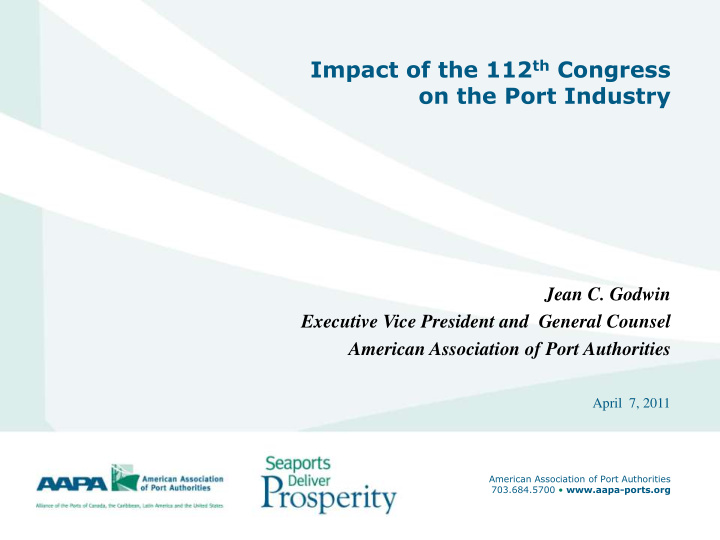



Impact of the 112 th Congress on the Port Industry Jean C. Godwin Executive Vice President and General Counsel American Association of Port Authorities April 7, 2011 American Association of Port Authorities 703.684.5700 • www.aapa-ports.org 1
American Association of Port Authorities Representing Seaports of the Western Hemisphere • 150 Members from throughout Western Hemisphere • AAPA provides a space for collaboration and exchange of best practices • Fostering collaboration among members and allied groups. We do this through: • Education and Training • Networking and one on one interaction • Legislative and Policy support • Outreach 2
Seaport Industry Overview Committed to Keeping Seaports Navigable/Secure/Sustainable • For centuries seaports have been an economic lifeline • Seaports help build and grow international trade; strengthening local and national economies • Provide high paying jobs and increase standard of living • Seaports connect us to the rest of the world • Keeping seaports modern, navigable, safe and in the national interest is a CORE PRIORITY for AAPA 3
Seaports as Critical Link to Global Trade • Seaports are a critical link to global marketplace, and AAPA and its members are committed to keeping seaports modern and efficient. • Seaports support 13 million jobs/strong family wages • Every $1 billion in exports creates an estimated 15,000 jobs in the U.S . American Association of Port Authorities 4 703.684.5700 • www.aapa-ports.org
The Role that Seaports Play to the Economy Cannot be Overstated • Nearly everything we buy or consume – everything from the clothes we wear, to the foods we eat, to the coffee we start our day with – comes to us on a ship, through one of our nation’s seaports. • In turn, nearly everything the United States sells in the global marketplace makes its way there via our seaports. This includes valuable domestic commodities like machinery, steel and building materials. 5
Seaports as Partnerships • A successful seaport is supported by its partners including federal, state and local governments and the private sector. • Ports are investing over $2 billion/year in their facilities, and rely on the federal, state and local governments to uphold their end of the bargain maintaining the waterside and landside connections to ports. • Modern, navigable seaports are vital to international commerce, economic prosperity and must remain a federal priority, even in these times of fiscal restraint. 6
Need for Investment and a STRONG Federal Partner • Maintaining our national infrastructure that supports foreign and interstate commerce is not only a Federal responsibility but is in the national interest. • Navigation channels and connecting landside infrastructure are • Investing federal, state, local and private resources into seaports and connecting infrastructure is critical 7
AAPA U.S. Policy Issues Existing transportation programs do not adequately address goods movement! • AAPA policy focuses heavily on improving port infrastructure and connections through greater investment in: • Federal navigation channels and marine highways - On the waterside, federal navigation channel dimensions are not keeping pace with needs (especially with Panama Canal expansion) • Port, road and rail infrastructure - On the landside bottlenecks often outside port gates 8
112 th Congress • New Leadership in Congress • Moratorium on earmarks directly affects our waterways • Timing, scope and funding for surface transportation legislation uncertain 9
Landside Access Pending Surface Transportation Legislation Overdue: Ports advocating for greater focus on freight transportation including: • National Freight Policy • Funding for projects/corridors of national/regional significance • Funding for intermodal connections to ports (highway/rail/maritime) • • Match transportation policy with trade promotion policy 10
Waterside Access Federal navigation channels not being maintained at authorized dimensions • cargo. Without routine dredging, ships are limited from entering certain waterways or cannot sail with full cargo loads, which ultimately increases costs to consumers. • The federal government does not fully utilize the Harbor Maintenance Tax (HMT) for its intended purpose and critical dredging needs have been neglected. (only half the required dredging is done): • Needs = $1.3-1.6 billion annually • Collected = $1.5 billion annually • Appropriated = $800 million annually • Only a fraction of user fees are being spent resulting in increased costs for waterborne transportation, higher prices to consumers and reduced competiveness of U.S. exports in the global marketplace 11
Navigation Channels Need Deepening Panama Canal expansion increases available draft to 50 feet • With ships getting increasingly larger and with Panama Canal expansion, dredging deep-draft navigation channels is critical • Need to increase navigation channel deepening & widening investments to help keep U.S. globally competitive • Without deeper channels we cannot take advantage of new export opportunities 12
What Lies Ahead • on the land and waterside to increase competitiveness and our ability to accommodate trade growth/expanded exports. • In the port industry we are up for the challenges and planning for what comes next: • Demonstrating the importance of ports both nationally and locally through jobs, the economy, trade • Demonstrating that prosperity will come through seaports and a strong and efficient transportation system 13
Thank you! 14
Recommend
More recommend